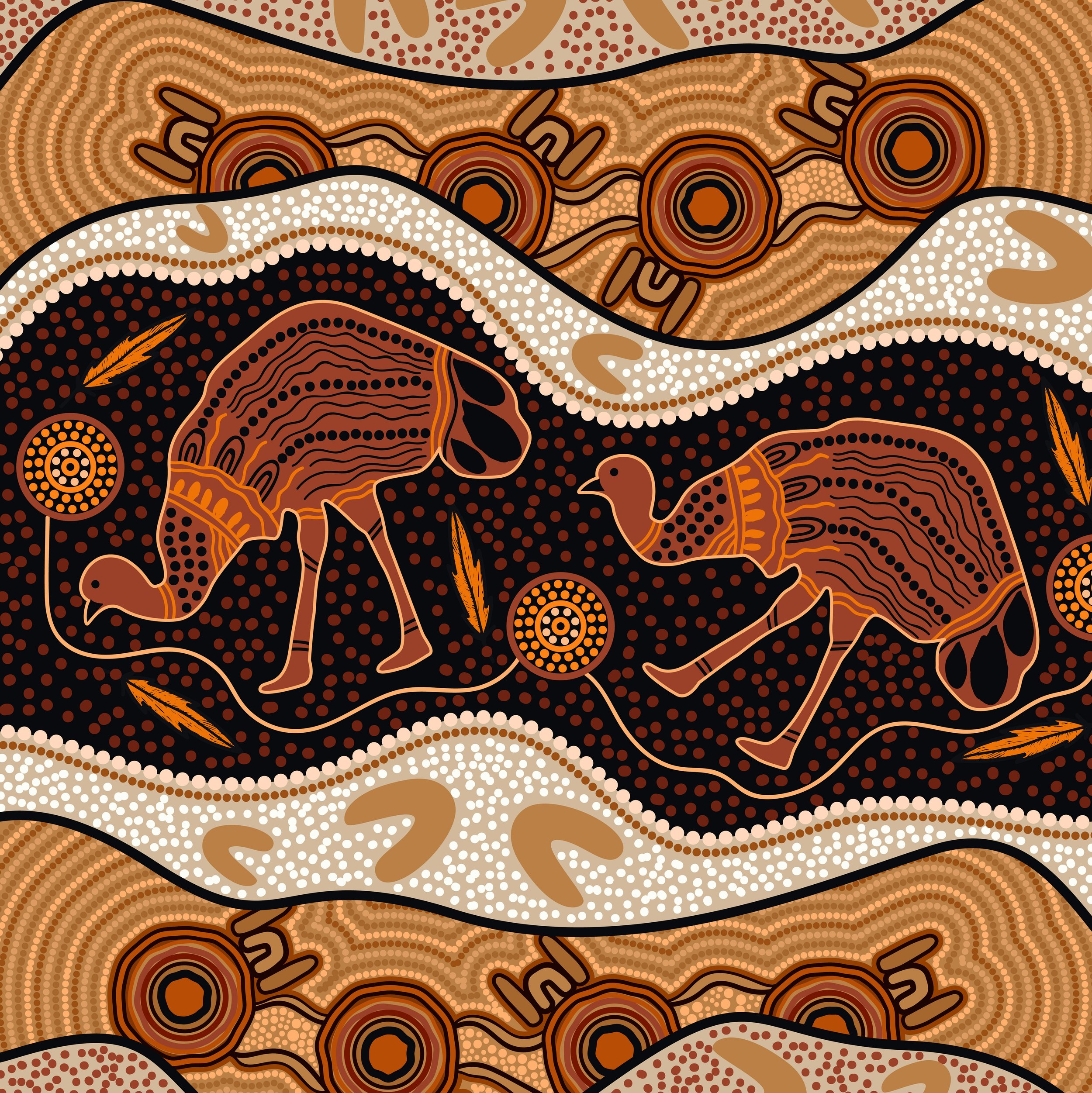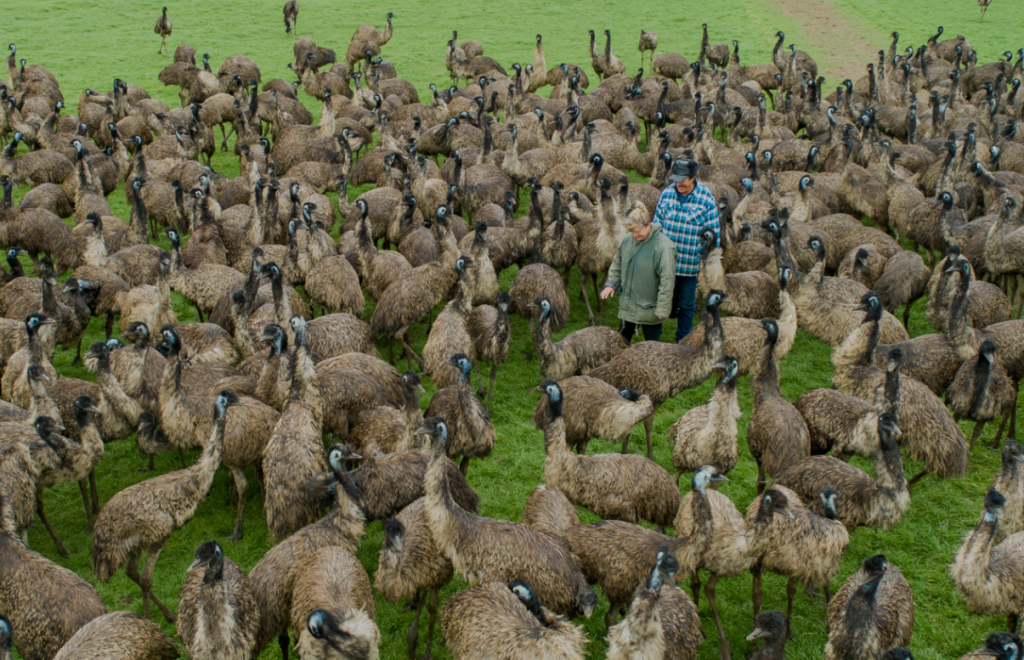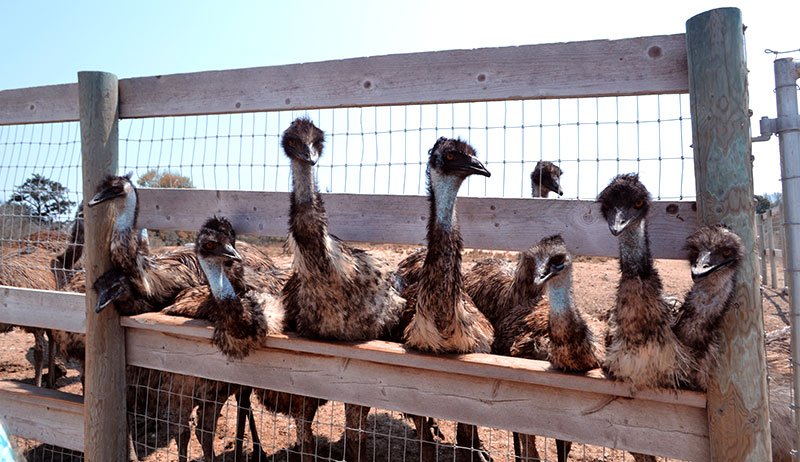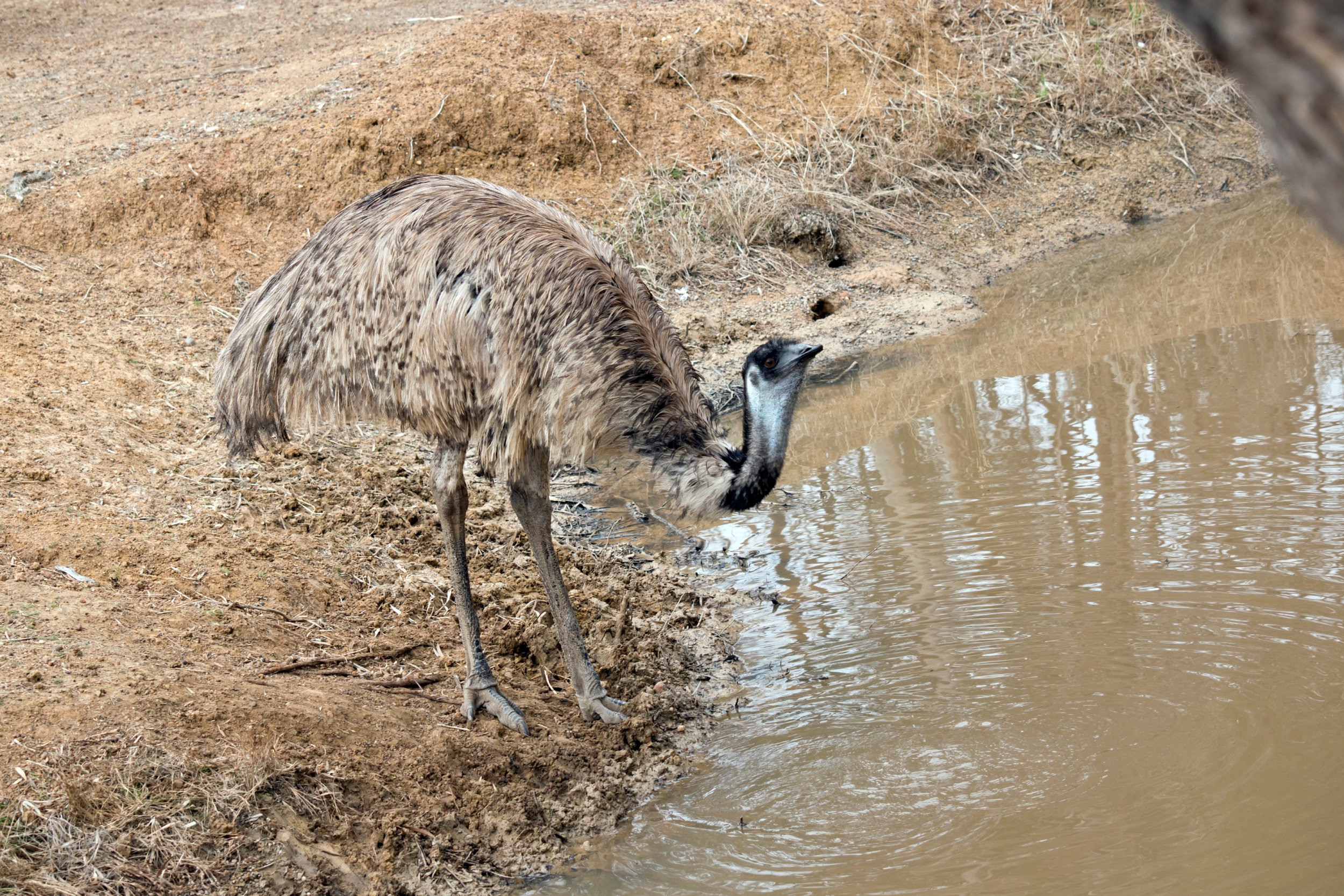
Emu farming
The mass farming of Australia’s native flightless birds.

Emus are the second largest flightless bird on the planet. Belonging to the ratite family, they stand up to 190cm tall and weigh around 55kg. Emus are native to Australia and play an important ecological role within the ecosystem as seed dispersers. One emu scat (dropping) can contain thousands of seeds and because they travel large distances, they are vitally important to the health of the landscape. Sadly, emus are farmed across Australia for their oil, skin, eggs and feathers and despite having a natural lifespan of up to 10-12 years, these majestic birds are killed before they reach two years old.
Wild living emus face increasing threats from climate change and diminishing habitats.
Emus as individuals
-

Emus are nomadic animals and walk up to 25km each day in search of food. They are paternal carers with females laying between 5-15 eggs before promptly moving on to breed again. The male will sit on the eggs for 55 days without eating, drinking, or defecating, and rarely leaving the nest, commonly losing approximately 8kg during this process. Once their emu chicks hatch, their father will stay with them for up to two years, protecting them and teaching them how to search for food and other important life skills.
-

Emus are diurnal animals who sleep through the night and search for food, preen and rest during daylight hours. They typically travel in pairs, but can be seen traveling in mobs when searching for new food sources. Emus are omnivores and are known to eat a range of fruits, seeds, insects, snails, shoots, flowers, small animals and animal droppings. They are known to softly whistle to one another whilst they search for food as a means to communicate. When food is scarce, emus can tap into the fat reserves stored on their back and are able to go weeks without eating if there is enough in their reserves.
-

Emus have the ability to detect water from hundreds of kilometres away, helping them navigate Australia’s harsh drought conditions. They are known to love swimming and will frequently submerge their bodies in water, soaking their feathers to cool off.

Emu farming
In the 1970s, the Australian Government permitted 300 wild emus to be captured as “a primary breeding stock for domestication”. This was after zoos in the United States started breeding and selling emus in the 1940s, proving that it could be achieved in captivity.
In 1996, there were estimated to be 500 emu farms across Australia. By 2018, that number had dropped to less than 12. Between 2005 and 2009, there were no new commercial emu farms developed and some left the industry or decreased their scale. However, of those that remain, some have a capacity to confine over 6,000 emus on a single farm. Of all species of birds commercially farmed in Australia, the welfare of farmed emus has been the least studied. A recent Australian review found that while chickens had over 400 studies investigating their captive welfare, emus had just three.
Breeding
Research suggests that natural mating is the prominent method currently utilised in emu farming. However, the industry has been forthcoming about their interest in developing "reliable" artificial breeding practices, so that emus can be subject to genetic manipulations through selective breeding, in an effort to make them more “economically viable”.
Across the farming world, artificial breeding practices are consistently stressful and hugely invasive. Further, the genetic manipulation of animals for agriculture has, historically, focused only on increasing economic viability, often at the expense of the overall health and wellbeing of animals. The desire to develop such breeding practices should be a cause for great concern given the potential health risks emus could face if such developments are successful.
Development of artificial breeding practices in emus
The semen that is collected is then used in the artificial insemination of females. Artificial insemination of female ratites involves a person rubbing or touching a female’s back, the base of her tail and the sides of her abdomen to encourage the sexual crouching position. This is followed by a person forcing a “semen straw” inside of her to deposit the semen.
Given artificial breeding is viewed as the only practical method to “genetically improve” ratites, continued research and trials are undertaken to establish methods to do so. These artificial breeding processes involve a human arousing the animal so that they may take advantage of their reproductive organs.
For male ratites, this requires the use of teaser and dummy females in order to collect semen. The teaser method follows normal courtship and mating behaviour until the male’s phallus is redirected into an “artificial cloaca”, a device mimicking the natural body part of a female.
The consequences of artificial breeding
Take for example the genetic manipulation of broiler (meat) chickens, who now grow at a rate 300% faster than chickens in the 1960s, reaching slaughter weight at just 4-6 weeks old. Broiler chickens commonly experience joint issues, splayed legs and difficulty walking, under the enormous weight their immature skeletal system is forced to carry, which can result in them being unable to access food and water. Further, sudden death syndrome is a metabolic disorder that occurs in 1-4% of broiler chickens due to rapid growth, commonly causing convulsions as they die. Ascites, or free fluid within the body cavity, occurs when their juvenile hearts start to fail as they have to pump harder to move enough blood around their overgrown bodies; heart failure and death often follows.
Industry-standard mutilation:
Declawing
The amputation of an emu’s toe, referred to as "toe-trimming" or “declawing”, is a legal, standard industry practice across the farming of ratites. This involves the removal of the end of day-old emus’ toes to “decrease skin injury caused by claws and to reduce stereotypic aggression”. Such amputations are also carried out because it is thought to minimise the risk of injuries to handlers during transport to slaughter.
Due to the unnatural living conditions imposed on ratites in farms, the risk of them causing injury to one another is high, either accidentally or through acts of aggression that arise from boredom and frustration in their inadequate living conditions. These injuries will ultimately damage the “final product”, namely their skins, thereby making them less profitable for producers. Toe trimming is the industry's way to negate such damage and maximise overall profits.
A hot blade, often a repurposed beak trimming machine used for poultry, is used to cut off the end of emus toes, preventing them from regrowing. Some standards also suggest that shearers are an appropriate tool to perform this procedure.
Despite the industry’s insistence that the toe trimming is in the best interests of their welfare, it is important to acknowledge that if animal welfare was a priority, animals would not be placed in living conditions that make such a procedure necessary in the first place.
More on emu farming
-
Australian Codes of Practice allow for emus to be raised in intensive, semi-intensive and free-ranging conditions. Intensive operations, commonly known as factory farming, are often a more desirable option for producers as more product (skins, oil, eggs and meat) can be produced on a smaller area of land.
On farms, emu chicks are deprived of the important paternal guidance they would ordinarily get in the wild when they spend two years with their fathers learning life skills. Instead, chicks are placed into group housing from the time they hatch.
Australian Codes of Practice outline a number of flippant suggestions around the housing of ratites, with a clear lack of regard for their wellbeing. This allows subjectivity in determining the needs of the birds by producers, and as such, inconsistencies in keeping practices from farm to farm.
-
Intensively raised animals are always placed at a higher risk of illness and disease outbreak due to the crowded and unhygienic housing they live in. Ammonia and urine commonly build up in housing facilities, which can lead to respiratory issues and burning of the eyes and nostrils.
Emus raised under factory farm conditions are known to suffer from panting, bodily swelling, coughing and lameness.
-
Codes of Practice mandate the killing of chicks who are deemed abnormal, deformed, or “unthrifty”. This is done through cervical dislocation or decapitation. Put bluntly, any animal that might require extra care or differ from the norm should be killed because they won’t be economically viable and will require too much time and care to raise.

Seed dispersers reduced to living in
barren paddocks
As aforementioned, the ecological role of emus is to spread seeds, promoting the growth of new flora in the environment. Despite this incredible role in nature, emus are kept in large barren, fenced off paddocks, that seldom have grass, and are mostly just dirt.
Presumably, this is due to high stocking densities placing pressure on the ground, preventing new growth. Not only do these farms place emus in captivity within their own environment, they are done so under such conditions that they have a negative ecological impact, making the ground unfavourable to grow anything at all.
Transport
Transportation is generally accepted to be particularly stressful for emus. Though Australian codes of practice outline that transport of ratites should be kept to a minimum, in the absence of abundant slaughtering facilities this is often impractical. In Australia, ratites are known to be transported for up to a massive 36 hours.
Slaughter
Prior to being killed ratites are denied food for 24 hours, however when coupling that with the time they travel on trucks to slaughtering facilities, they are likely to be deprived of food for much longer.
Codes of practice outline emus should be retrained and stunned or shot with a captive bolt gun before their throats are cut and their bodies bled out. Slaughter methods have been found to cause significant stress and both electrical stunning and captive bolt stunning are known to often be ineffective or inaccurate. This can result in either multiple attempts at stunning, causing further pain and suffering to the animal, or leaving them to be slaughtered while they are still conscious/sensible to pain.

Emus abroad
Though emus are native to Australia, they are commercially farmed in other parts of the world. Today, there are large emu farming industries in India and the United States. In the mid-1990s over 300 Canadian farmers transitioned to the farming of ratites, including emus. During the same period, emu flesh was marketed in America as “the next red meat”.
Emu farming abroad, however, has been problematic and largely unsuccessful. This is because emu farming cannot realistically compete with the farming of “traditional” farmed animals, such as cows. In many ways, this resembles the sale of other products derived from Australian species elsewhere in the world. Kangaroo meat, for example, suffers from an “image problem” as only a small number of consumers appear willing to consume this “novel” product.
Alternatives are available
Emus deserve better than to be exploited and killed on their own country. So, let’s do better - for them.
Plant-based alternatives
to emu oil
Thankfully there are numerous wildlife-friendly alternatives to emu oil that don’t subject emus to a life of exploitation. Emu oil is used in both cosmetics and therapeutic treatments, including soaps, hair products, and deodorants. It is also used to treat joint and muscle pain, inflammatory bowel disease, skin conditions and arthritis. A plant-based alternative to emu oil has been developed that can be used in the same way as emu oil.
Emu oil has anti-inflammatory properties due to its high levels of fatty acids and omega oils. Both of these can be derived from plant-based alternatives including hemp seed oil, hemp seed oil capsules, or plant-based omega tablets.
A just transition out of
emu farming
The emu farming industry is a relatively small one in Australia, with only a handful of farms still in operation. In 2019, the owners of one farm admitted a lacking market for emu meat, explaining much of it was being dumped or used for pet food. This is obviously a huge issue, creating large amounts of waste.
In Australia, this industry has been difficult for producers, who are often struggling to make ends meet, or to establish the markets needed for a profitable business.
Government funded programs to support these farmers in a transition away from the farming of native wildlife, to more sustainable and wildlife friendly employment alternatives, is essential to a just transition for farmers and emus.
Make the pledge to become a Wildlife Defender!
Each of us have incredible power to create meaningful change - let’s use it. You can play an important role in the protection of Australia’s unique wildlife. Take the pledge to become a Wildlife Defender today and join a growing community of people defending the wild.














